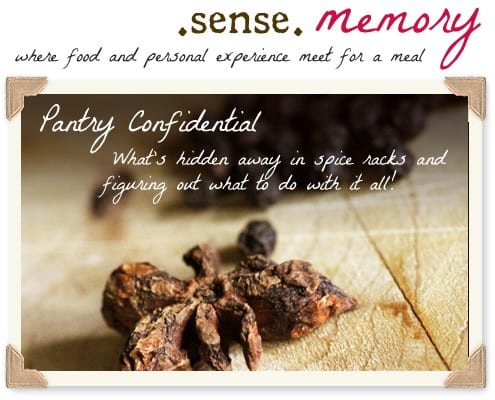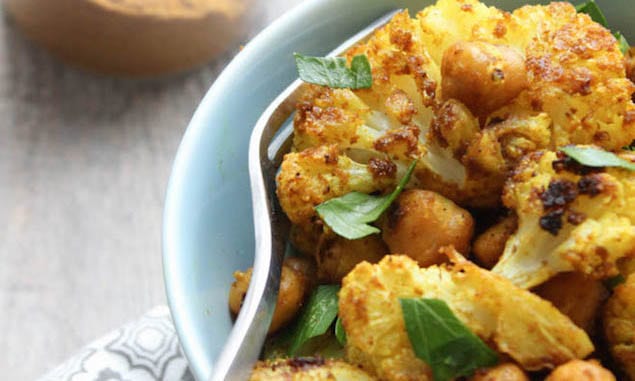Denise Sakaki is a freelance food writer and photographer who…
Denise Sakaki asks that ancient, universal question. – What’s in your spice rack?
By Denise Sakaki

I opened up our pantry door and was struck by the collection of spices, dried herbs and seasonings. Or more to the point, feeling somewhat baffled over how we wound up with so much. Our cupboards are surely bewitched, as I’ve peered inside and been surprised to find not two, but three large containers of ground cinnamon, with no clue over how they multiplied. I blame Narnia – there must be a crossed wire between the Wardrobe and my pantry, and I’m getting stuck with their ground spices. There’s a long-running joke between myself and the Mister about cumin – in his bachelor-pad days of living in a house with roommates, they always wound up with a stockpile of the tan, smoky seasoning generally used for chili or tacos, likely from one person not being sure if they had the spice and bought a new bottle. Multiply by four or five roommates and you’ve got a spice-hoarder household in the making.
Having a surplus of spices and seasonings isn’t a bad thing. In cold months, dried herbs like thyme and oregano are a staple when fresh ones aren’t as available. Ground spices like the tart-flavored sumac can add strong, exotic flavors to food. The benefit of dried herbs and spices is that their shelf life is fairly stable, most keeping their freshness for about six months. And there’s little concern over them going bad or making someone ill. The potency of their flavor will diminish over time, but you can simply add more. Whole spices like nutmeg or cloves can stay fresh even longer, their intact form retaining flavor before being ground or crushed as-needed. Despite having a busy kitchen where ingredients move in and out at a fairly fast pace, I’m still stuck with a Spice Cabinet of Curiosities, and I know I’m not the only one.
I started asking around to see who else has a hodge-podge of pantry goods. The most frequent offenders included: MSG, star anise, cardamom, grains of paradise and garam masala. Check your cupboard right now – you’d be hard-pressed to not find at least one of these items tucked away in a corner.
People shared some of their own Pantry Confidential stories of ingredients they remain locked in a staring contest with:
“I’ve consulted my current spice rack and I don’t know what to do with the following: ground nutmeg? Paprika? Oregano? And a small bottle of aromatic bitters. I can’t imagine I ever bought any of these so I’m curious if they managed to just grow in the dark or something.” – Charles Liotta, from Seattle, WA
“In my cupboard: Agar powder – uses besides glazing doughnuts? What other types of dishes use mace and would there ever be a reason to use in place of nutmeg?” – Katrina Thomas, from Kirkland, WA
“I don’t know why I have cardamom!” – Sue Anthony, from Phoenix, AZ.
“Chinese 5-spice. I’m Chinese, and don’t know what to do with it.” – Daniel Jeung, from Woodinville, WA
“Is spam an herb? I have a whole jar of star anise that we used to cook pork belly with. But the leftover sneers at me in the dark every time I open the cupboard.” – Chairul Sugiharto, from Jakarta, Indonesia.
Even if I can barely clean my own pantry out, I can at least give a few helpful suggestions over controlling some of the pantry spice overpopulation:
Cardamom, Mace and Nutmeg: As a ground spice, they can be added to both sweet and savory dishes. Cardamom adds a fragrant flavor to things like Indian dishes and nutmeg adds a smoky depth to cream sauces. Mace is the outer part of a nutmeg seed and can be used in place of nutmeg. These flavors work well in sweet, creamy desserts, like rice puddings or flavoring whipped cream. Consider crushing the whole spices and infusing them in warm milk to be added to tea or coffee.
Chinese Five-Spice Powder and Star Anise: These are strong, heavy flavors best suited for meaty dishes like slow-cooked pork ribs or to deepen the flavor of a beef stir fry. Whole spices like the star anise are strong; use sparingly, but consider adding a couple to a large pot of mulled wine or cider, along with other whole spices like cinnamon or cardamom, to balance out the sweetness.
And no, Spam is not an herb, but its shelf life will surely outlive all those extra bottles of cumin.
Denise Sakaki is a freelance food writer and photographer who is always searching for the connections between food and personal experience. She is the creator of the food blog Wasabi Prime and contributor to Serious Eats, 425 Magazine and Drink Me Magazine.




My current system is re-sing small glass and plastic jars and bottles and writing on their tops. It’s working really well, my spice drawer used to be completely out of control! My favourite spices? Smoked paprika, lemon myrtle…
Thanks for the entry, can totally relate, had a good little giggle!
*re-Using